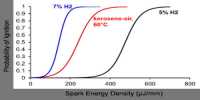Clearly solid and liquid will often be in co-existence and the viscosity is a factor in any application. This can be determined from the classical penetrometer test. In the test the penetration of a needle into a 100 g sample of the subject pitch at 25°C is determined, contact with the needle have been of five seconds’ duration. From the results the dynamic viscosity can be calculated according to:
µ(poise) = 5.9 x 109 /(penetration depth)1.93
where the penetration depth is in units decimillimetres: 1 decimillimetre = 10-4 m.
The penetration depth across a range of pitch samples was found in to range from 1.0 to 195 decimillimetres.
That values of the viscosity of coal tar pitch are exceedingly high is confirmed in much more recent work than that in. Li and Li present results for dynamic viscosities of pitch, including one of 16000 kg m-10 at 200°C. Using the same density as previously, this gives for the kinematic viscosity:
ⱱ = 16000 kg m-1 s-1 /1000 kg m-3 = 16 m2 s-1 ≡ 1.6 x 107 cSt
This corresponds quite closely to the value at a much lower temperature for the pitch in [6] having given a penetration depth of 195 decimillimetre.
Viscosity of fluids can be determined from the rate of exit of a sample fluid under gravity through an orifice. Time of the order of decades is required for a value of the viscosity of a coal tar pitch to be obtained in this way. At the University of Queensland in 1930 such an experiment was commenced [8], and it is still in progress! The first drop exited in December 1938 and seven further drops between then and November 2000. Fitting of the results so far has given a value for the dynamic viscosity:
μ = 2 x 108 kg m-1 K-1
ⱱ = 2 x 1011 cSt
which is of the same order of magnitude as one of the values in.











